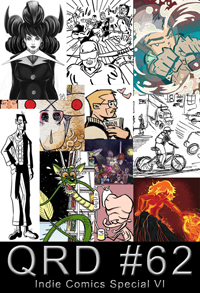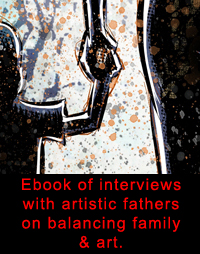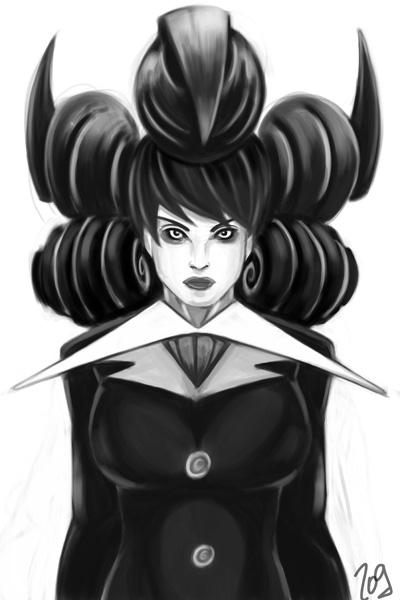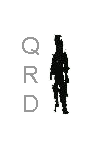
 |
| about
this issue Indie Comic Creator Interviews: Jay Payne Steven Myers William Dean Blankenship, Jr Ted Intorcio Lucas Herr Troy-Jeffrey Allen Jeff Gibbons Brian Hagen Nils Balls Eric Grissom Eric Ratcliffe Steve Peters |
 |
 |
 |
 |
 |
 |
 |
|
|
       |
May 2013

City: Washington, DC
Comics: Bamn, Dr. Dremo’s Taphouse of Tall Tales, Crystal Clear
Websites: www.bamncan.com & jayapayne.deviantart.com
QRD – How old were you when you first got into comics & did you always stick with them or did you come back to them?
Jay – I first got into comics as a young teenager. As a kid, my mother worked for the State Department, so I traveled a lot which made it hard for me to stick with them. While living in Ecuador, I attended an American International College & stumbled into comics again. It allowed me to rediscover my love for them.
QRD – What was the first comic book you ever bought?
Jay – A Spider-Man comic. I don’t know which one, unfortunately.
QRD – How old were you when you put out your first comic?
Jay – I was 25.
QRD – What decade do you think produced the best comics?
Jay – Obviously the 80s.
QRD – Why comics instead of just writing or drawing?
Jay – Watching the process of both mediums working together is a lot of fun to be a part of.
QRD – Do you see mini-comics & indie comics as a path to mainstream comics or as their own unique media?
Jay – I see them as their own unique media.
QRD – How many copies of your comic do you print in your first run?
Jay – We printed 100.
QRD – How much do you think comics should cost?
Jay – A nickel.
QRD – How many books do you produce a year & how many would you like to?
Jay – For the most part, one. We’ve managed to produce more on occasion. Honestly, if life didn’t get in the way, we’d love to produce all the things.
QRD – Do you think stories should be serialized or delivered as complete works?
Jay – Both? Maybe? I guess it depends on how much exposition is needed in a story. I don’t think there is any best way to approach that. Trial by trial.
QRD – How are comic strips different than comic books & which medium do you prefer?
Jay – Comic books can represent complete works & strips can be an ongoing collection of short works. I enjoy both mediums but if I had to choose one... I prefer comic books.
QRD – How long is it from when you start a comic until it’s printed?
Jay – It can take months. The worse case is a full year. I design all of it, I draw it, color it, & I coordinate things with the printer. It’s a long process even with a writer helping.
QRD – What do you do better with your comics now than when you first started?
Jay – Everything. I’m constantly trying to improve the overall quality of the book. People keep telling me to not be a perfectionist, but I can’t help it. I’m my own worse critic.
QRD – Do you do thumbnails?
Jay – No, but I should.
QRD – At what size do you draw?
Jay – Standard 8.5x11 & 11x17.
QRD – What kind of pens do you use?
Jay – Faber-Castell for inking & Copic markers.
QRD – What does your workstation look like?
Jay – A desk surrounded by computer junk & comic books. I work off of two screens, one of which is a Cintiq. I’m kind of walled off in my computer fortress.
QRD – At what point in the artistic process do you work digitally?
Jay – From the very start I work mostly digitally. We did things traditionally for the first two issues of Bamn, but once this Wacom came into our lives there was no turning back.
QRD – What do you think of digital comics & webcomics?
Jay – I think they offer a new experience for comic books & comic book readers. It’s the future of comic book consumerism.
QRD – Do you prefer working in color or black & white?
Jay – Both? My only concern is the story. I’m slowly working on a superhero comic with Shawn Padriac Murphy while I do Bamn. It made sense to do color for that. The story demanded it.
QRD – How many different people should work on a comic & what should their jobs be?
Jay – As many people as it takes to produce a comic at a reasonable pace. Their jobs should be decided on their strengths to ensure efficiency. Our biggest issue on Bamn is that it’s just Troy & I. We carry it from start to finish. It’s very time-consuming, but we refuse to give up.
QRD – How do you find collaborators?
Jay – Going to conventions. Because of things like SPX & SPACE we’ve really expanded our network. Some of those people have been incredibly helpful in terms of marketing the book.
QRD – How tight do you think a script should be as far as telling the artist what to draw?
Jay – The writer & artist need to work well together & really understand what it is that each individual is trying to achieve. I think the script can be as tight as the writer feels is necessary.
QRD – What comic book person would you be most flattered to be compared to?
Jay – Adam Hughes, Terry Dodson, & maybe Frank Cho. I’m a pinup fan. It’s obvious once you see my prints, I think.
QRD – What do your friends & family think of your comics?
Jay – They pretend to like it.
QRD – What do you think of superheroes?
Jay – I think they’re awesome. Superman remains my favorite. He just embodies so much of our potential. What’s not to like?
QRD – Marvel or DC?
Jay – DC. I’m a sucker for iconography.
QRD – What comic characters other than your own would you like to work with?
Jay – Power Girl. Come by the table & you’ll probably catch me sketching either her or Wonder Woman.
QRD – Ideally would you self-publish?
Jay – Yeah, I believe in the american dream. I mean, self-publishing is the first step to achieving your goal in this business. Seizing that opportunity is very important.
QRD – What conventions do you try to attend & why?
Jay – Baltimore Comic Con & Small Press Expo because those were my first conventions. We always prioritize those two for that exact reason. We would hate ourselves if we didn’t show at BCC & SPX.
QRD – What do you do to promote your books?
Jay – Keep going to conventions. That face-to-face is indispensable.
QRD – Do you think your comics are well suited to comic shops or would sell better elsewhere?
Jay – I think we’re on the way to being suitable for comic shops & elsewhere. We’ve been doing career day events at some local schools. Seeing how kids react to comics really shifts your perspective. You start to really think of new ways to make your book accessible to all.
QRD – What other medium would you like to see some of your comics made into (television, film, games, action figures, etc.)?
Jay – All of the above. At our weekly meetings, we spend so much time talking about movies & how to capture the same emotion of a particular scene in our book. It helps us come together on ideas. I’d be lying if I didn’t say movies factor into Bamn’s process quite a bit. If the opportunity was presented to make a film out of it, I think we’d be very happy with that. Video games are destined to be a big part of Bamn’s future too. That’s all I’ll say about that for now.
QRD – Do you consider yourself a comic collector or a comic reader or both?
Jay – I consider myself a comic reader. I fell in love with Axe Cop not too long ago. I just love the unrestrained imagination.
QRD – What do you see as the most viable mediums for comics distribution 10 years from now?
Jay – Digital online distribution, as is everything else.
QRD – What would you like to see more people doing with comics?
Jay – Since living in Ecuador, I’ve never seen many schools or colleges use comics as a form of teaching literature. It would be nice to see that as a common practice. It’s such a great gateway.
QRD – Anything else?
Jay – Thank you for the interview. I hope I was somewhat interesting.
